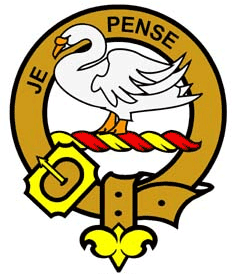Wemyss Clan
Wemyss Clan Crest: A swan.
Wemyss Clan Motto: Je Pense (I think).
History of Clan Wemyss:
The first of the surname on record is Michael de Wemys, who was also called Michael de Methkil, both territorial in association. In 1291, a Charter was confirmed on Sir John, son of Michael de Wemys, by Gamel, Bishop
of St Andrews.
In 1290, Sir Michael and Sir David Wemyss were despatched to Norway to bring back the infant Queen Margaret, the 'Maid of Norway.' Six years later, Sir Michael rendered homage to Edward I of England, but that
did not prevent him from supporting Robert the Bruce and, as a consequence, Wemyss Castle was attacked by the English. Sir Michael's son, Sir David, was among the signatories of the Declaration of Arbroath sent to the
Pope in support of Robert I.
In succeeding generations, members of the Wemyss family were hostages for the release of David II and James I from English captivity.
Sir David de Wemyss was killed at the Battle of Flodden in 1513, and Sir John Wemyss fought at the Battle of Pinkie in 1547. Sir John was a staunch supporter of Mary, Queen of Scots and fought on her behalf at the Battle of Langside in 1568. His great-grandson, John Wemyss of that Ilk, became a Nova Scotia Baronet in 1625 and given a Charter for the Province of New Wemyss in Canada. Raised to the Peerage as Lord Wemyss of Elcho in 1628, he became High Commissioner to the General Assembly of the Church of Scotland and was created Earl of Wemyss by Charles I.
With the wealth accrued from the family's salt and coal mines, the 2nd Earl constructed at his own cost the harbour of Methil in 1649. The 3rd Earl was a Commissioner of the Treaty of Union between Scotland and England in 1707.
The 5th Earl married the daughter of Colonel Francis Charteris of Amisfield, and their eldest son, David, Lord Elcho, accompanied Prince Charles Edward Stuart until his final defeat at the Battle of Culloden in 1746, thereafter escaping to France. As a result, he was attainted, but the situation was retrieved by his younger brother Francis who changed his name to Charteris on inheriting his maternal grandmother's estates. The Wemyss Estates in Fife and the Arms of Wemyss, however, devolved to a third brother James, who became Wemyss of Wemyss.
The great-great grandson of James married the granddaughter of William IV, and their son Michael married Lady Victoria Cavendish-Bentinck, god-daughter to Queen Victoria who founded the Wemyss School of Needlework and lived to be 104.
Surname distribution in Scotland: The highest concentrations of the Wemyss name occur in Highland (includes the historic counties of Caithness, Inverness-shire, Nairnshire, Ross and Cromarty and Sutherland), Aberdeen City, Aberdeenshire (includes all of the historic counties of Aberdeenshire, Kincardineshire and part of Banffshire) and Fife.
Places of Interest:
Wemyss Castle, Fife. Seat of the Wemyss Family since the 12th century. It was here that Mary, Queen of Scots first met her future husband, Lord Darnley.
Wemyss School of Needlework, Coaltown of Wemyss, Fife. Tapestry School created by Lady Victoria Wemyss.
The Wemyss Ware Pottery Studio, Ceres, Fife. The world renowned Wemyss Ware was named in honour of the Wemyss family of the nearby Wemyss castle.
Wemyss Clan membership prints.

